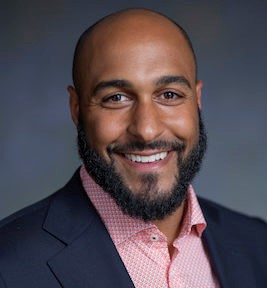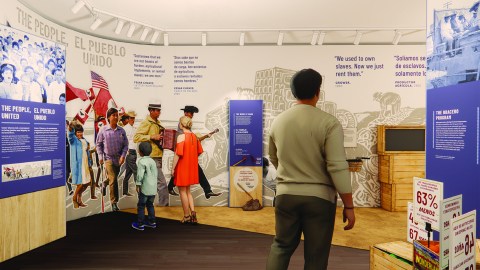
With its forthcoming report, Excellence in DEAI, AAM seeks to help museums achieve excellence in diversity, equity, accessibility, and inclusion.
This article originally appeared in the January/February 2022 issue of Museum magazine, a benefit of AAM membership.
The museum field is incredibly diverse. It includes all-volunteer museums with no staff and those with more than 1,000 staff members. Museum budgets range from just a few hundred dollars to hundreds of millions annually. And museums of all types cover the spectrum of disciplines—from art museums to zoos—including historic sites and houses, history museums, science centers, children’s museums, nature centers, botanic gardens, natural history museums, and aquariums.
Museums are stewards of our culture, hold deep public trust, and strive to promote understanding and education. As such, our standards of excellence must expand to celebrate and honor what is beautiful about all of us, not just a select few. They must center equity in museum culture, strategy, processes, policy, and practice to ensure all our communities’ voices, perspectives, and experiences are represented in the field.
In 2017, AAM published Facing Change: Insights from the American Alliance of Museums’ Diversity, Equity, Accessibility, and Inclusion (DEAI) Working Group, which reinforced how DEAI is integral to excellence in museum practice and marks another step in a decades-long commitment to build a stronger, more representative, and inclusive community for all. The report explicitly called out DEAI as a core tenet of the standards of excellence in the museum field.
In 2019, as a component of Facing Change: Advancing Museum Board Diversity & Inclusion—an unprecedented national initiative to diversify museum boards and build inclusive museum cultures backed by the Andrew W. Mellon, Alice L. Walton, and Ford foundations—AAM assembled a task force of museum leaders with expertise and experience with the Continuum of Excellence in a range of museum disciplines and sizes. The task force was charged with developing recommendations to embed DEAI more deeply into the Alliance’s standards and excellence programs, including accreditation.
Then 2020 hit our field with force: COVID-19 closed many museum doors, and the murder of George Floyd sparked protests across the nation. Amid that social, political, and cultural polarization, and clear evidence of structural racism in the United States and around the world, AAM, with support from AAM’s Excellence in DEAI Task Force recommendations, needed to produce a statement report that met this particular moment in our nation’s history—to support the field in building alignment and understanding of DEAI in concrete ways.
The report, Excellence in DEAI, is intended to be a starting point for spurring conversation and action that advances excellence in DEAI in the museum field. No matter where they are starting in this process, all institutions, not just some, need to come together as a collective in order to move DEAI work in the museum field forward. In addition to offering institutional-level guidance to help museums do this, the report is also AAM’s launching point for a process to reexamine and embed DEAI best practices into our excellence and accreditation programs.
How to Use the Report
While not an exhaustive “how-to” that fully addresses the unique circumstances of each museum, the report lays the groundwork that allows our field to establish a common set of Core Concepts and Key Indicators of excellence in DEAI. The Core Concepts outlined in this article and the report serve as overarching themes of excellence in DEAI, while the Key Indicators are the tactical practices indicative of progress within each Core Concept.
These are broad indicators because AAM understands there is no one-size-fits-all approach to DEAI work. We believe that every museum should use these as guiding principles rather than a prescriptive checklist. Some museums will have progressed further along certain Core Concepts than others, while others will have specific DEAI challenges they need to prioritize.
The Core Concepts and Key Indicators were developed from the task force’s research and recommendations; broad input obtained during listening sessions held during the 2019 and 2020 AAM Annual Meeting & MuseumExpo; feedback from multiple AAM stakeholders, including the Accreditation Commission; and direct input from AAM staff. The report notes areas for further exploration within AAM’s Framework for Museum Excellence, including a stronger, more explicit integration of DEAI into both the AAM Code of Ethics for Museums and Core Standards in the years to come.
The Core Concepts and Key Indicators
To make progress in DEAI, the museum field must acknowledge that transformational institutional and collective culture change is absolutely required. The Core Concepts and Key Indicators below are AAM’s attempt at building a fieldwide understanding and alignment around what museums, no matter where they are in their journey, should be considering when thinking about their DEAI work. They are not listed in particular order as all of them hold equal significance.
Core Concept: DEAI is an ongoing journey without a fixed endpoint.
As with AAM’s excellence continuum, DEAI work is an ongoing journey. Transforming organizational culture and operationalizing equity must be a permanent, cross-functional element of museum management and administration.
Key Indicator: Take a holistic approach, integrating DEAI into all aspects of the museum’s operations through a process of assessment, reflection, capacity building, iteration, and measurement.
Whether a museum is just embarking on this journey or has started this work already, it is essential that it do its DEAI work relative to its size and resources and scale up as it builds momentum and capacity along the way.
Adaptability is a key characteristic of this progression. Museums today operate in a dynamic and complex world. Museums that practice DEAI excellence exhibit an orientation toward flexibility—an ability to constantly adapt by incorporating feedback from their community, peers, the field, and other sources into their programming and space. Adaptability requires vulnerability, meaning that museums must be able to take in hard truths and act on them. Effectively doing so creates opportunities for different people to have a voice and enables the museum to more proactively and effectively respond to external stimuli.
Key Indicator: Publicly commit to the ongoing work of transforming organizational culture and dismantling systems of inequity within individual museums and the communities they serve, the museum sector, and society broadly.
Museums are the most trusted institutions in the United States. Our commitment to this DEAI work is a moral imperative because museums have the power to shape culture in broader society. Systemic oppression of all forms, including racism, is embedded into the fabric of our society. Museums are not immune to this fact, so it is on us to make sure we are committed to this work in the long term.
Core Concept: DEAI demands an ongoing commitment of resources.
Resource allocation decisions, especially demonstrated in a budget, reflect a museum’s values and priorities. To operationalize equity cross-functionally and sustain excellence, museums must commit significant financial and human resources to the effort. The importance of the work should be reflected in the museum’s annual budget as well as within the scope of responsibilities of all museum staffers, each of whom should have explicit goals for the operationalization of equity within the scope of their role and function.
Key Indicator: Provide financial resources for staffing, capacity building, and internal or external DEAI expertise.
Depending on its size, type, and structure, a museum should have at least one of the following: a dedicated staff person whose scope of work is devoted exclusively to the operationalization of equity and the coordination of this cross-functional body of work across the museum; and/or a board committee assigned such responsibility; and/or access to consultants who have the knowledge, expertise, capacity, and positional power to drive and measure change.
Core Concept: DEAI is the responsibility of the entire organization.
In order to both drive and sustain DEAI work, it must be reflected in all aspects of museums, including the individuals, organizational culture, policies, and processes. This work must not rely solely on the people of color, LGBTQ+ community, or disability community within your museum, and the HR function should not be solely responsible for it.
The work around DEAI is everyone’s responsibility, from the board and c-suite to middle managers, junior staff, and volunteers. The importance of the work should be reflected within the scope of responsibilities of all museum staffers, each of whom should have explicit goals for the operationalization of equity within their role and function.
Key Indicator: Adopt equity as a cornerstone of the museum’s mission, strategy, values, management, and culture.
In order for the museum field to make and sustain measurable progress toward DEAI, museums must adopt equity as a cornerstone of their missions, strategies, values, management, and culture. Equity work, or the mitigation of identity-based disparities both within the museum and in the broader community, must permeate everything that a museum believes and works toward. The closer a museum can align its mission and strategy toward achieving more equitable outcomes, the better positioned it will be in creating a culture that supports DEAI more consistently.
Key Indicator: Embed responsibility and accountability for implementing DEAI policies and process into operations, job descriptions, and performance reviews at all levels of the institution, from the board of directors and c-level executives to senior leaders, middle managers, junior staff, and volunteers.
Building on the work codified in Facing Change: Insights from the American Alliance of Museums’ Diversity, Equity, Accessibility, and Inclusion Working Group, museums must contend with the pivotal role of boards and leadership in marshalling DEAI in their institutions. Without strong executive leadership and governance buy-in and support, the intentional process to operationalize equity cross-functionally and prioritize DEAI goals cannot be initiated or successfully sustained. Although excellence is a responsibility shared among all members of a museum community, the power and responsibility for organizational direction-setting lies with those at the top.
Core Concept: DEAI work must be measured and assessed.
Today, equity—the elimination of policies, practices, attitudes, and cultural messages that reinforce differential outcomes by identity—has become a pillar of AAM’s work on behalf of the field. Equity requires deliberate attention to internal metrics tied to recruitment, hiring, compensation, promotion, and retention. But in order for the museum field to move its collective equity work forward, we all must align around the fact that working toward equity means narrowing identity-based disparities, both within our museums and in the communities we serve.
Key Indicator: Define the museum’s equity goals as the elimination of identity-based disparities.
As museum professionals and as organizations, we are either actively working to mitigate identity- and ability-based disparities or we are perpetuating them. Due to the nature of structural oppression, a museum does not need overt bigotry and oppression to take place for those things to exist within its walls. We need only look at the racial leadership gap within the field to know that structural inequity is embedded in the systems and culture of our field.
Key Indicator: Measure progress by disaggregating data by identity over time.
Transparent and consistent measures of accountability are essential to DEAI work, particularly in aligning institutional efforts across the organization. As individual museums and as a collective field, we must normalize the collection and measurement of demographic information internally and externally and disaggregate that data by identity. By using longitudinal outcomes data—in which participant outcomes are collected at multiple intervals—we can narrow identity-based disparities both within individual museums and within the field broadly.
What’s Next
Over the next several years, AAM will release complementary assessments, toolkits, and resources to support museums in working toward the outlined Core Concepts and Key Indicators. Each Core Concept and Key Indicator has a specific focus and intention, so documents, examples, and resources will be designed to expand on the high-level recommendations outlined throughout this report.
We know the journey toward excellence in DEAI is always ongoing. We all come to conversations regarding DEAI from different starting points, and we each possess unique visions for success. Our individual and institutional processes for achieving excellence may vary, but the need for progress has never been more urgent.
Resources
AAM, Excellence in DEAI
Forthcoming in early 2022








Is there a list of consultants that specifically work with Museums on DEAI?